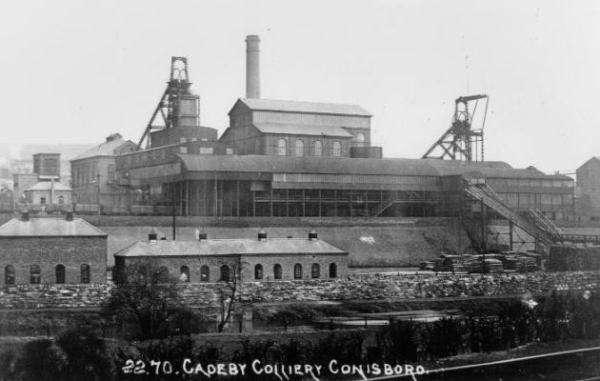
Cadeby Colliery 1920s
Used with kind permission from Conisbrough & Denaby Main Heritage Group
The Denaby Main Co. chose the site for Cadeby Main in order to work reserves of the Barnsley seam within it Denaby colliery’s take. It was confined to a small area between the Cadeby Cliff and the Dearne Valley Line and the River Don. It was, however, on the south-east or downthrow side of the Don Valley Fault. This threw the coal down 115 metres and meant that in places the normally shallow dip reached 1 in 3.
Because the Don is navigable to Conisborough, the colliery had a staith for shipping coal to the Humber. Upstream, boats could use the Sheffield & South Yorkshire Navigation. At first the colliery was only linked to the M.S.&L.R’s Barnsley to Barnetby line. This was soon joined by the South Yorkshire Junction Railway (later L.N.E.R. Denaby Branch) and the L.N.E.R’s Dearne Valley line.
Work began on sinking two shafts in March 1889. Large inflows of water meant that continuous cast-iron tubbing was used to line the shafts to a depth of 128 metres. The Barnsley seam was reached at a depth of 687 metres, and the shafts completed, in February 1893 with production starting later that year. It was worked until exhausted in 1966.
With its new colliery proved, the company restructured itself as the Denaby & Cadeby Main Collieries Ltd in 1893. In 1924 the Parkgate seam was developed by drifts from the Barnsley seam and it was worked until 1947. In 1936 the company became part of Amalgamated Denaby Collieries, which included: Denaby Main, Cadeby Main, Dinnington Main, Rossington Main & Strafford Main. It worked Cadeby until nationalisation.
The 0.86 metres thick Beamshaw seam was opened in 1944 and worked, at a depth of 578 metres, until 1966. Under the NCB the Dunsil seam was worked from 1952 to 1964. 1956 saw the Haigh Moor (aka Swallow Wood) came on stream, and it was worked until 1982. Also in 1956 Cadeby and Denaby Main were linked underground and all coal was wound at the former. The two collieries were officially merged on March 23rd 1968.
The Dunsil seam was re-entered in 1974 and worked until poor geological conditions forced the colliery’s closure on November 7th 1986. The surface plant was demolished and cleared in 1987.
On the 9th July 1912 a series of explosions rocked the pit; the first claimed the lives of 35 men and the second 6 hours later killed colliery managers & members of the rescue team who had gone to search for survivors killing 53 of them. After a third explosion the following day access to that section was sealed and the men withdrawn from the pit. The full report can be found here.
Further reading:
- National Archives: BT31/31319/39391 (1893) – Denaby & Cadeby Main Collieries Ltd
- National Archives: BT31/38534/313935 (1936) – Amalgamated Denaby Collieries Ltd
- NMRS Records, Gazetteer of British Collieries
- Sections of Strata of the Yorkshire Coalfield, Midland Institute of Mining Engineers, 1927
- Hill, A. The South Yorkshire Coalfield: A History and Development (Stroud: Tempus, 2002)
- Hill, A. Colliery Ventilation (Matlock: Peak District Mines Historical Society Ltd, 2000)
- Hill, A. Coal: A Chronology for Britain (NMRS, British Mining No.94, 2012).

